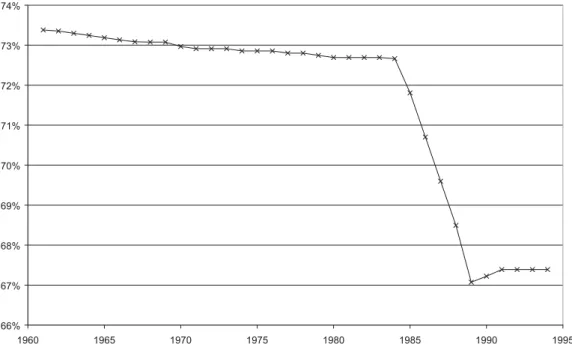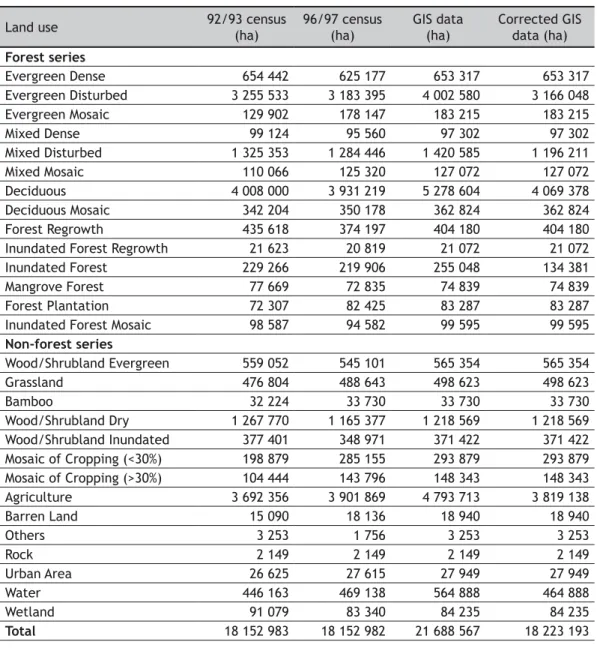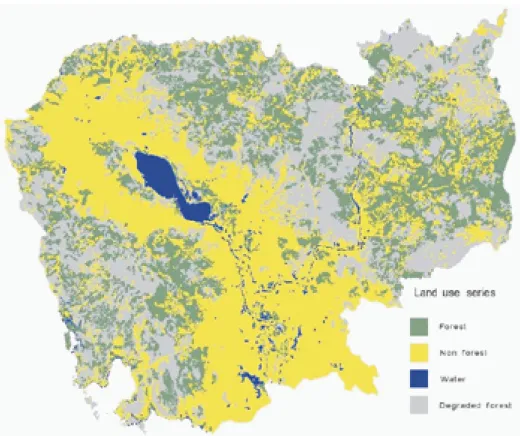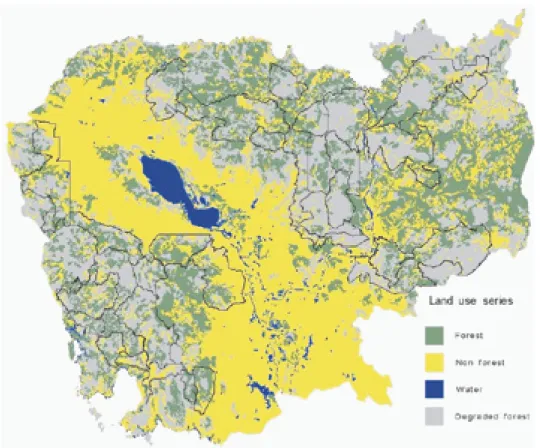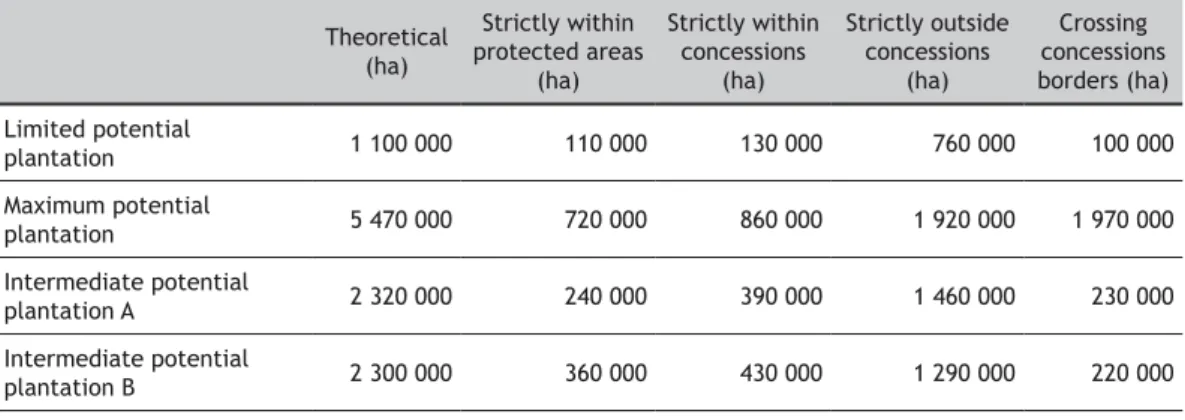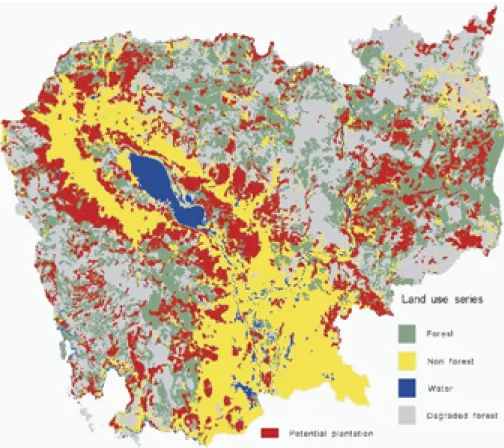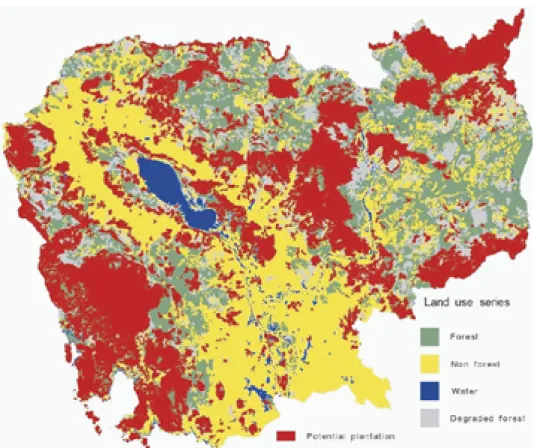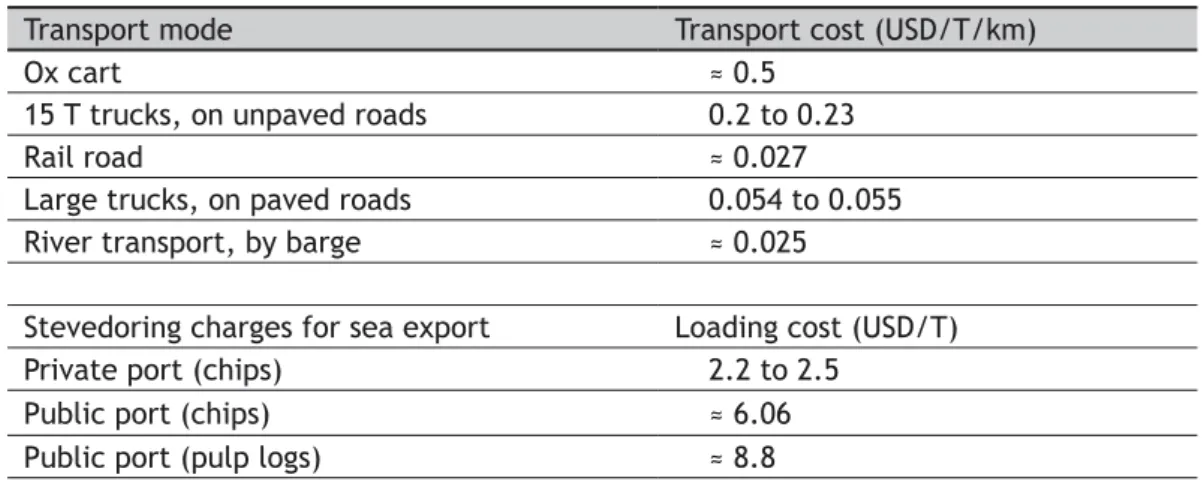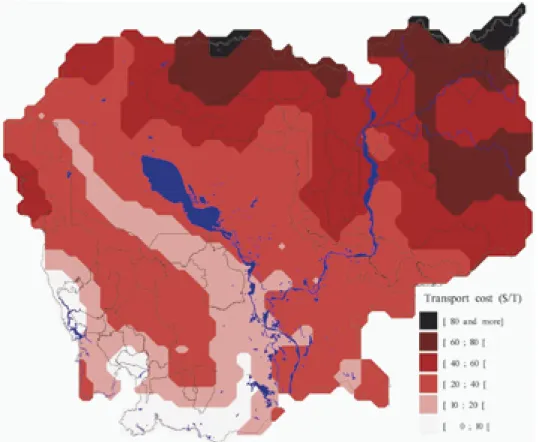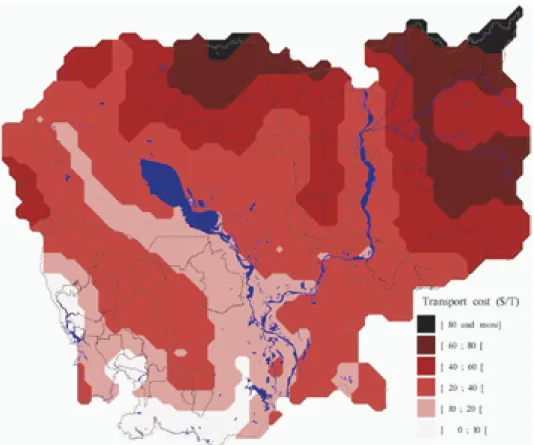HAL Id: cirad-00192170
http://hal.cirad.fr/cirad-00192170
Submitted on 27 Nov 2007HAL is a multi-disciplinary open access archive for the deposit and dissemination of sci-entific research documents, whether they are pub-lished or not. The documents may come from teaching and research institutions in France or abroad, or from public or private research centers.
L’archive ouverte pluridisciplinaire HAL, est destinée au dépôt et à la diffusion de documents scientifiques de niveau recherche, publiés ou non, émanant des établissements d’enseignement et de recherche français ou étrangers, des laboratoires publics ou privés.
To cite this version:
Jean-Marc Roda, Santosh Rathi. Cambodia Report : Feeding China’s Expanding Demand for Wood Pulp: A Diagnostic Assessment of Plantation Development, Fiber Supply, and Impacts on Natural Forests in China and in the South East Asia Region. CIFOR. CIFOR, 32 p, 2006, CIFOR, �10.0000/http://www.cifor.cgiar.org/Research/Governance/Projects/forest_trade.htm�. �cirad-00192170�
Demand for Wood Pulp:
A Diagnostic Assessment of Plantation
Development, Fiber Supply, and Impacts
on Natural Forests in China
and in the South East Asia Region
Jean-Marc Roda &
Santosh Rathi
Cambodia
r e p o r t
ISBN 979-24-4675-3
Feeding China’s Expanding
Demand for Wood Pulp:
A Diagnostic Assessment of Plantation
Development, Fiber Supply, and Impacts
on Natural Forests in China
and in the South East Asia Region
Cambodia
r e p o r t
Jean-Marc Roda & Santosh Rathi
(CIRAD)
Center for International Forestry Research
Mailing address: P.O. Box 6596 JKPWB, Jakarta 10065, Indonesia Tel.: +62 (251) 622622; Fax: +62 (251) 622100
E-mail: cifor@cgiar.org
Web site: http://www.cifor.cgiar.org
This document has been produced with the financial assistance of European Community through Asia Pro Eco Programme. The views expressed herein are those of the authors and can therefore in no way be taken to reflect the official opinion of the European Commission.
Forest series and other land uses 1 State of the forests 3 Potentials for pulp wood plantations 5
Wood plantation development
9Incomplete information 9
Facts 9
A know-how gap between stakeholders - need for capacity building 10
Prospective analysis: the pulp and plantation sector
11Optimised transport cost model for Eucalyptus or Acacia
pulpwood exports 11 Uncertainties regarding export costs 14 Chinese market – Eucalyptus pulp logs scenarios 2 and 3 15 General market – Eucalyptus pulp logs scenarios 4 and 5 15 General market – Eucalyptus chips scenarios 6 and 7 17
Corporate actors and strategies
17Business environment 17 Resultant strategy 18
China’s demand footprint
19Social footprint 19 Technical footprint 20 Revealing criterion for suspicious projects 20
Context
After decades of war, Cambodia is one of the world’s poorest nations, its economy and its political life are still suffering from the civil war that racked the country during the latter part of the 20th century. Rice and rubber were traditionally the principal exports of
Cambodia, but exports fell sharply after the onset of the civil war, which put most of the rubber plantations out of operation. By the 1990s, however, rubber plantings had been undertaken as part of a national recovery program, and rubber and rice were again being exported. The fishing industry has also somehow been revived, but some food shortages continue. From this period, the largest source of export income has been timber, until the Cambodian government set up a “log export” ban in 1995.
With a rather limited national environment supporting the development of an internationally competitive wood processing industry, this industry sector has not benefited from this ban. Wood material exports have continued under a limited processed form, i.e. squared logs and thick boards. Up to now, no development of any wood pulp or chipping industry has been impossible in Cambodia.
Additionally, in 2002, any logging activity has been suspended for any forest companies, until the approval of their new forest concessions. Some forest companies which had old logs (harvested before 2001) were still authorized to process them. Further, in 2003, a large portion of the territory (about 24%) was declared as protected area.
The industrial growth of the country is now mainly sustained by the garment and tourism sectors. But until now, inadequate transportation hampers the development of national industries, except in some “development pockets”. This poor transportation is a major impediment for the development of pulp wood plantations or pulp and chipping industries in Cambodia.
Wood supply sources
Forest series and other land uses
The forest cover of Cambodia has been decreasing from 75% in 1965 to its current level. According to FAO data, a dramatic drop in the forest cover occurred during the 1980s, this being related to the war (FAOSTAT, Figure 1).
According to other different sources, Cambodian forest series now account for more than 10 million ha (that is between 58% to 60% of forest cover), and non forest series account for more than 7 million ha (Figure 2). The most detailed information come from the official censuses established in 1992/1993 and in 1996/1997 (Cambodian Forestry statistics 2002). It describes the land uses into several forest and non forest series, according to photo interpretation from satellite imagery. This information has been cross checked with another GIS data set provided by a NGO. The NGO GIS data set is referred as “GIS data” and raises some questions about the quality of the digitalising work1. This
NGO “GIS data” presents what seems to be some major inconsistencies coming from an overlap of the digitalised series, which ends up in an exceeding area of more than 3 million ha for the whole country2. Once corrected by CIRAD, the GIS data provides
satisfying data, slightly different from the official census, but consistent, and with a total error of 0.39% on the whole country area (Table 1). The forest series consist of evergreen forests (4 million ha), in deciduous forests (4.43 million ha), in so-called “mixed” forest, or semi-evergreen (1.42 million ha), in inundated forests and vegetation (0.33 million ha), and in plantation forests (0.08 million ha). The existing plantation forests consist in fact mainly in rubber plantations.
66% 67% 68% 69% 70% 71% 72% 73% 74% 1960 1965 1970 1975 1980 1985 1990 1995
Figure 1: Evolution of forest cover in Cambodia (FAO data)
Table 1: Detailed land use series, according to different sources
Land use 92/93 census(ha) 96/97 census(ha) GIS data(ha) Corrected GIS data (ha)
Forest series Evergreen Dense 654 442 625 177 653 317 653 317 Evergreen Disturbed 3 255 533 3 183 395 4 002 580 3 166 048 Evergreen Mosaic 129 902 178 147 183 215 183 215 Mixed Dense 99 124 95 560 97 302 97 302 Mixed Disturbed 1 325 353 1 284 446 1 420 585 1 196 211 Mixed Mosaic 110 066 125 320 127 072 127 072 Deciduous 4 008 000 3 931 219 5 278 604 4 069 378 Deciduous Mosaic 342 204 350 178 362 824 362 824 Forest Regrowth 435 618 374 197 404 180 404 180 Inundated Forest Regrowth 21 623 20 819 21 072 21 072 Inundated Forest 229 266 219 906 255 048 134 381 Mangrove Forest 77 669 72 835 74 839 74 839 Forest Plantation 72 307 82 425 83 287 83 287 Inundated Forest Mosaic 98 587 94 582 99 595 99 595
Non-forest series Wood/Shrubland Evergreen 559 052 545 101 565 354 565 354 Grassland 476 804 488 643 498 623 498 623 Bamboo 32 224 33 730 33 730 33 730 Wood/Shrubland Dry 1 267 770 1 165 377 1 218 569 1 218 569 Wood/Shrubland Inundated 377 401 348 971 371 422 371 422 Mosaic of Cropping (<30%) 198 879 285 155 293 879 293 879 Mosaic of Cropping (>30%) 104 444 143 796 148 343 148 343 Agriculture 3 692 356 3 901 869 4 793 713 3 819 138 Barren Land 15 090 18 136 18 940 18 940 Others 3 253 1 756 3 253 3 253 Rock 2 149 2 149 2 149 2 149 Urban Area 26 625 27 615 27 949 27 949 Water 446 163 469 138 564 888 464 888 Wetland 91 079 83 340 84 235 84 235 Total 18 152 983 18 152 982 21 688 567 18 223 193
State of the forests
The Cambodian forest has been aggressed by several factors over the years (defoliant bombing by US army during Vietnam war, deforestation for subsistence agriculture by displaced populations, shifting cultivation, unmanaged logging). The forest series cover has in fact to be classified into probably preserved forests (5.11 million ha, Figure 3) and into degraded forests (5.56 million ha, Figure 3). The latest consists into disturbed forests (4.79 million ha) and mosaics of forest and agriculture (0.77 million ha). Among the total forest series, 3.30 millions ha are classified as protected areas (Figure 4), and 5.35 million ha are classified as concession areas (Figure 5).
Figure 3: Forest cover and degraded forest areas
Potentials for pulp wood plantations
The following considerations do not include any questions on neither the economic values nor the ecological values of the discussed strategies. Ecological values are not discussed in this report, but economic values are discussed in a subsequent chapter.
From a very theoretical point of view, two strategies can be discussed in order to asses the potential for wood pulp plantation. All strategies should avoid taking in consideration lands used by some population for their shifting cultivations or other agricultural needs. Particularly, the different forest mosaics and mosaics of crops belong to this category (Table 1).
A first option considers a category of lands which do not belong to the forest series, but which could be suitable for pulp wood sylviculture. Unused evergreen shrublands (0.57 million ha), grasslands (0.5 million ha), and bamboo lands (0.03 million ha) belong to this category. It forms a “limited theoretical potential” accounting for around 1.1 million ha (Figure 6). In some particular cases, dry shrublands maybe suitable too, and taking this serie into account would very theoretically extend the potential to an “intermediate theoretical potential A” of around 2.32 million ha (Figure 7).
A second option extends the potentially suitable areas by extending it with the degraded forests. Today, the Cambodian government already choose this strategy. According to Cambodian government officials some concessions can be conceded in forest series when they are already too degraded to insure an acceptable regrowth of the forests, and when they would likely to remain under a desolated state for a long period. The area of these “too degraded” forests is unknown, but their extent can theoretically include all the disturbed forest series except inundated series where the pulp wood
plantations are impossible. Adding disturbed evergreen forests (3.17 million ha) and disturbed mixed forests (1.2 million ha) would increase the area up to a “maximum theoretical potential” accounting for around 5.47 million ha (Figure 8).This scenario is clearly excessive. Without a detailed data about the state of degraded series, an exact assessment of the potential for pulp wood within the degraded series is impossible.
What is still possible is an assessment considering the sensitivity of large audiences (i.e. NGOs) for this potential extension. For example, interviews with NGOs suggest a non scientific preference for the protection of evergreen forest series. Taking in account this non scientific preference by including only disturbed mixed forest series in the extension for potential plantation, would lead to an “intermediate theoretical potential B” of 2.3 million ha (Figure 9).
In fact the above numbers and subsequent figures are only theoretical, since a part of the considered areas is located under protection areas, and another part is located outside both protection and concession areas. For a realistic assessment, one should avoid the “maximum potential” scenario, and should take in account the “limited potential” scenario under concessions as bottom line, then the “intermediate potential A” scenarios under concession as probable values, and finally the “intermediate potential B” scenarios but outside concessions for a theoretical further extent of the areas (Table 2).
Thus, the bottom line of the potential for wood pulp plantations would be around 0.13 million ha, the probable potential would be between 0.39 an 0.43 million ha, with a theoretical further extent of 1.51 to 1.89 million ha.
Again, these assumptions do not take in account any economic feasibility, which is evaluated in another chapter, and which would temper the numbers.
Table 2: Precised potentials for possible pulp wood plantations
Theoretical (ha) Strictly within protected areas (ha) Strictly within concessions (ha) Strictly outside concessions (ha) Crossing concessions borders (ha) Limited potential plantation 1 100 000 110 000 130 000 760 000 100 000 Maximum potential plantation 5 470 000 720 000 860 000 1 920 000 1 970 000 Intermediate potential plantation A 2 320 000 240 000 390 000 1 460 000 230 000 Intermediate potential plantation B 2 300 000 360 000 430 000 1 290 000 220 000
Figure 6: Limited theoretical potential for pulp wood plantations
Figure 8: Maximum theoretical potential for pulp wood plantations
Wood plantation development
Incomplete information
With a very low national consumption of paper, there has never been any real projects for the development of pulp wood plantations in Cambodia until recent years. There is no official information, and the only widely and publicly available information is generated by NGOs.
In 2002, the World Rainforest Movement has stressed out wood plantation projects in Cambodia among other countries as a “pulp invasion” (Lang 2004). According to the World Rainforest Movement report, a company named Pheapimex, owned by Mrs Chung So Pheap, has contracted around 300 000 ha of concessions in Pursat and Kampong Chnang provinces, in order to develop Acacia and/or Eucalyptus pulp wood plantations. These future plantations would provide a pulp and paper mill, to be set up in Kandal Province. The concessions regard “spare forest” lands in the quoted provinces. The subject of the “Pheapimex chapter” of this report is to highlight the potential environmental effects of monocultures of Acacia and Eucalyptus, as much as the potential negative effects of the paper mill on the Tonle Sap lake, and the underlying conflict with the local population.
Beside the undisputable points regarding existing and potential conflicts with local populations, the report mixes consistent and non consistent data, which lessens its credibility. For example, the environmental claims against Acacia and Eucalyptus in Pursat and Kampong Chnang provinces are supported by incantations rather by scientific evidence. Another example, the Kandal province is not located near the Tonle Sap lake, but along the Mekong river, near the Vietnam border. Thus the potential effects of the pulp and paper mill project could not have an impact on the Tonle Sap lake. Furthermore, the Cambodian economic and political environment, as well as the national resource and market environment, still do not support good prospects for a pulp and paper mill project. The information about such a mill project is not corroborated by any other sources.
In early 2005. Global Witness stressed out the association of Pheapimex and “WuZhiShan LS”3, a Chinese “plantation company”, and their contract for a concession in
Mondul Kiri province. According to Global Witness, Pheapimex and the WuZhiShan Group acquired 200 000 ha concession and triggered conflicts with the local population.
While the occurrence of conflicts with local populations is very probable, it is unlikely that the Chinese plantation company as an entity is an illegal concession. According to another source (Reuters), the WuZhiShan Group would have been rather granted with a 10 000 ha concession in Mondul Kiri province, and would have been promised a further 190 000 ha.
Facts
Our own field work allowed us to interview four of the top business persons of Cambodia. These people are the most influential people in forestry activities and tree plantations. The interviews were very professional, and the discussed points were about techniques and economics of transportation, plantation, and forest production in Cambodia. Business strategies and business plantation development were also discussed.
There are only three serious plantation projects in Cambodia, among which only one is targeting the production of pulp wood for exportation purpose. The two other projects are targeting timber production, which need different tree species and different sylvicultures. Another project is very theoretical, and is not supported by a feasibility analysis.
- The theoretical plantation project would be to develop a pulp wood plantation in Koh Kong or Kampot provinces. This is supported by the proximity of private and public harbours, which should allow the lowest possible transportation cost for pulp wood
export. But this project has not yet found both investors and available land, and has not yet any solid basis. Some available and suitable areas exist in the region, but they are too few, too fragmented and not big enough to allow a real industrial feasibility. Furthermore, other possible plantations like agro-food plantations present a better economic interest.
- One plantation project is located in Ratanak Kiri province. It is targeting only timber production. The feasibility of a pulp wood production has not been studied for this particular project, but some elementary evidences indicate that its opportunity cost would be too high.
- One plantation project is located in Mondul Kiri province. This is the project quoted by Global Witness. It is indeed a project were the WuZhiShan group has invested, but not in cooperation with Pheapimex. The joint-venture is established between WuZhiShan Group and another Cambodian group4. This project is also explicitly targeting timber
and/or resin production, based on pine plantations5.
- The last plantation project is located both in Pursat and Kampong Chnang provinces. This is the project quoted by the World Rainforest Movement. It is also a project where the WuZhiShan group has invested, but the joint-venture is established between WuZhiShan Group and another Cambodian group than Pheapimex6. This project is
targeting Acacia and Eucalyptus production for pulp wood export. As for the rest of the country, the major impediment of the profitability of such a project lies in the transportation costs. But the location of the project along the only railroad of Cambodia makes it the best possible place after the coastal region.
A know-how gap between stakeholders - need for capacity
building
Our interviews with the major actors for the Cambodian forestry scene allow us to point out a general lack of scientific and technical knowledge regarding pulp wood plantation and pulp and paper industries, and as a result, a tenseness of the positions of different stakeholders.
The industrial stakeholders display excellent competencies regarding timber harvesting, logistics, and industries. They also display a good knowledge of tree plantation for agri-food purposes. But they rely on foreign investors, actors, or experts when regarding ecology or technico-economics of pulp wood plantations and regarding pulp and paper industry in general.
The local NGOs stakeholders display excellent competencies regarding satellite imagery, computerised Geographic Information Systems, socio-economics and rural livelihoods, or information and journalism. They also display a good knowledge of wildlife and botany sciences. But they also display little interest for forestry sciences, economics, logistics, or industry. They also rely on preconceived ideas when considering pulp wood plantations and pulp and paper industry in general.
As a consequence, beside the real problems of the country, there is a false problem in Cambodia when considering the question of pulp wood plantations. The tension that is observed confuses the scientific, technical, economic, and business development questions with the governance issues. In order to better address the governance issues and to address the questions of pulp wood plantations with more serenity, both groups of stakeholders could benefit of capacity building programs. This could perhaps lessen the gap between the preoccupations of different stakeholders, but it would for sure allow to separate the questions according to their real domain, and to improve the level of the debate.
Prospective analysis: the pulp and plantation
sector
As a first critical element, the Cambodian economic and political environment, as much as the national resource and market environment, will not support good prospects for any pulp and paper mill project before a long time (if considering scales and costs to be competitive at the “southeast Asian region” market level). The only economically realistic prospects in the context of the pulp and paper sector would be plantation projects for exports out of Cambodia.
As a second critical element, the inadequate transport context of Cambodia hampers the development of all national industries, except in some “development pockets”. This poor transportation environment is a major impediment for the development of pulp wood plantations or pulp and chipping industries in Cambodia.
The following prospective analysis is thus based on an economic feasibility study of the transport costs in Cambodia, in the context of pulp wood plantation economics.
Optimised transport cost model for Eucalyptus or Acacia
pulpwood exports
According to the data from our field survey and interviews, we can parameterise the transport costs model for chips and pulp log transport in Cambodia. The costs range from 0.027 to 0.5 USD/T/km, depending on the transportation mode. The cost parameters for each transport mode, including intermodal costs before export, are presented below (Table 3).
We consider the existing and the potential industrial transport of pulp wood within the country up to the exit points where it can be sold “Free On Board” towards any export market as such as China. The country territory is represented by a spatial grid, constituted of a sufficient number of cells being as many territorial units. Field survey and data (location and state of different transportation networks, transportation costs, river ports, railways stations, sea ports, etc.) allow to compute and to assess any possible transport cost, from any territorial unit towards any export point (when exporting pulpwood or wood chips from industrial plantations).
We define a generalised transport cost model, were the pulpwood can be transported by various transportation modes, with differentiated transport costs. The considered transportation modes are :
- track and unpaved road - paved road
- railway - river
The transport can be unimodal or multimodal. The latest case occurs when the goods are unloaded and loaded from one mode to another one, at any intermodal point (i.e. from road to rail, at a rail station). The transport cost model allows to assess and to compare (for every territorial unit of the grid) the transport cost for every possible transport combination, from the forest to any export point, (unimodal and every multimodal combinations are computed). For every territorial unit, the lowest possible transport cost before export is considered as the transport cost criteria to be used when considering the potential of this place for an industrial plantation.
Denote c as the centroïd of territorial unit x among G territorial units in the grid. Denote i as the mode of transportation within the transportation mode index I describing n modes of transportation. Denote k as an intermodal point between transportation mode i and another one. Denote z as an export point among Z possible export points. Denote Di as the distance between 2 points and Ci as the transportation cost per kilometre,
according to the transportation mode i. We then have the transport cost model (1) :
[ ]
[ ]
[ ]
{
}
( )
[
[
[
[
( )
(
(
)
)
(
)
⋅
+
⋅
+
⋅
=
+∞
∈
∀
+∞
∈
∀
=
∀
=
⇒
=
=
=
=
∈
∈
∀
∈
∀
∈
∀
− − = + + +∑
n n n n n i i i i i i i i i iC
z
k
D
C
k
k
D
C
k
c
D
TC
C
D
i
k
k
n
i
n
i
Z
z
,G
c
,
,
,
min
,
0
,
,
0
,
4
river
4
railway,
3
road,
2
track,
1
,
,1
,1
,
1
1 1 1 1 1 1where TC is the lowest possible transport cost before export, regarding the territorial unit x.
(1)
The model can be derived into one generic transport cost model where loading points x in the plantation can be considered exactly as any intermodal points (in this case between the production stage to a transportation mode), and where export points z can also be considered exactly as any other intermodal points (in this case between the last transportation mode, and the export transportation mode, i.e. “sea”). We then have a generic multimodal transport cost model (2) derived from (1):
[ ]
{
}
( )
[
[
[
[
(
)
(
)
⋅
=
+∞
∈
∀
+∞
∈
∀
=
∀
=
=
=
=
∈
∈
∀
∑
= n i i i i i i iC
k
k
D
TC
C
D
i
k
k
n
n
i
n
i
1 2 1,
min
,
0
,
,
0
,
mode
tion
transporta
.,
railway,..
3
road,
2
track,
1
,
,1
where k1 and k2 are the two intermodal points (loading-unloading points) at the beginning
and at the end of the transportation mode i, and where TC is the lowest possible transport cost before export.
(2)
Table 3: Transport costs parameters in Cambodia
Transport mode Transport cost (USD/T/km) Ox cart ≈ 0.5
15 T trucks, on unpaved roads 0.2 to 0.23 Rail road ≈ 0.027 Large trucks, on paved roads 0.054 to 0.055 River transport, by barge ≈ 0.025
Stevedoring charges for sea export Loading cost (USD/T) Private port (chips) 2.2 to 2.5
Public port (chips) ≈ 6.06 Public port (pulp logs) ≈ 8.8
It is possible to draw different maps of Cambodia according to the transport cost model for Eucalyptus or Acacia pulpwood exports. One map represents the actual conditions, with the upper Mekong being unsuitable for large scale industrial navigation (Figure 10). The second map represents the possible conditions when the upper Mekong will be rehabilitated for industrial navigation (Figure 11). The simulations show that the rehabilitation of the upper Mekong have only a limited effect on the pulp wood or chips transport costs at the country scale, except in the areas neighbouring the Mekong. The improvement of the road transportations would certainly have much more effect, especially if it is designed according to the location of the potential plantation areas.
Figure 10: Actual transport costs for pulp wood or chips prior to export, with
Uncertainties regarding export costs
Beside the inland transport costs and stevedoring charges prior to overseas exports, there are other costs that are more difficult to realistically assess.
- Wood products support 5 to 10% of export duties according to their level and type of processing. Pulp logs, although having no specific taxation rate, would perhaps support a 10% export duty, as for wood sticks, split poles etc (44.04)7. Nor there is a
specific taxation rate for wood chips, and it would perhaps support a 10% export duty too, as for wood wool and wood flour (44.05)8.
- According to the NGO “Economic Institute of Cambodia”, informal taxes would exist for any kind of exports, and could account up to 7% of the FOB price.
- There is no regular shipping line9 from Cambodia to South China, where the current
and future major markets for pulp logs or wood chips are located. According to ASEAN, current shipping costs from Cambodia to China reach 45 to 58 USD/T. Assuming that regular lines could be established in the future, supported by a regular and significant production of pulp wood, could let assume that the shipping costs to China could easily decrease around 20 to 30 USD/T.
- Today’s pulp wood prices at mill’s gate in Southern China range from 28 to 37 USD/T (green ton), but the general markets FOB values in Southeast Asia are between 30 to 45 USD/T (green ton) for pulp logs10, and between 80 to 120 USD/T (air dry ton) for
eucalyptus chips.
Figure 11: Possible transport costs for pulp wood or chips prior to export, after rehabilitation
of the upper Mekong for industrial navigation, with delimitation of forest concessions
Imagining that some plantation pulp wood (as eucalyptus) would be available today for export towards China, the operation could not be profitable. The transport costs from Cambodia to China are indeed higher than the mills gate prices in China.
Balancing all the above uncertainties, it is possible to build 7 prospective scenarios for export cost structures, in order to delimit the different possibilities for pulp wood or chips exports out of Cambodia (Table 4).
Table 4: Prospective scenarios of export cost structures
Chinese market
Eucalyptus pulp logs Eucalyptus pulp logsGeneral market Eucalyptus chipsGeneral market Possible conditions Worst Best Ideal Worst Best Worst Best
Prospective scenarios 1 2 3 4 5 6 7
Mobile chipping costs (USD/T) - - - 15 15 Stevedoring charges (USD/T) 8.8 8.8 4 8.8 8.8 6.06 2.5 Export duties(%) 10.00% 10.00% 10.00% 10.00% 10.00% 10.00% 10.00% Informal tax (%) 7.00% 7.00% - 7.00% 7.00% 7.00% 7.00% FOB market price (USD/T) - - - 30 45 80 120 Sea chipping cost (USD/T) 20 20 20 - - - -Mill’s gate price (USD/T) 28 37 37 - - - -Mill’s gate price or FOB price
minus export costs (USD/T) -2 6 11 17 29 47 84
Using the above cost models, it is possible to compute a map of Cambodia for each scenario, with the delimitation of places where production and transport of Eucalyptus pulp logs or chips could be theoretically economically feasible. The real economic feasibility is not assessed, by lack of supplementary information about the fertility and productivity of plantations in the targeted areas, the production costs, and the targeted benefits.
Chinese market – Eucalyptus pulp logs scenarios 2 and 3
For the prospective purpose, we assume that the shipping costs to China could easily decrease down to 20 USD/T, when supported by a regular and significant production of pulp wood (Table 4, scenario 1, 2, 3). Even with this better transportation context, the export costs from Cambodia would still be too high compared to the minimum mill’s gate price (Table 4, scenario 1). But assuming that today’s conditions would be the same, with a decreased shipping cost to China, allow for some rooms for a pulp wood plantation development (Table 4, scenario 2). It would necessitate ideal conditions (Table 4, scenario 3), such as the best current Chinese price, a 50% decrease of the stevedoring charges11, and no informal taxes12, in order to create more than 10 USD/T available for
production and transport costs, and benefits. Theoretical feasibility of scenarios 2 and 3 are represented in Figure 12.
General market – Eucalyptus pulp logs scenarios 4 and 5
Conversely, prospects of sales to the general market place of Southeast Asia, in Free On Board (the seller does not take in charge the costs from the export port to the final market), provide more rooms for the development of the pulp wood plantations in Cambodia. Even the worst current FOB prices expects more than 15 USD/T available for production and transports costs, and benefits (Table 4, scenario 4). The best current prices is expected up to 29 USD/T (Table 4, scenario 5). Theoretical feasibility of scenarios 4 and 5 are represented in Figure 13.
Figure 12: Prospective area of plantation theoretical feasibility, producing Eucalyptus pulp logs
for the Chinese market (mill’s gate)
Figure 13: Prospective area of plantation theoretical feasibility, producing Eucalyptus pulp logs
General market – Eucalyptus chips scenarios 6 and 7
Finally, the best scenarios are logical when considering exports of chips to the general market place of Southeast Asia (FOB sales, from the export port). These scenarios take into account the strong hypothesis of modern and mobile chipping devices, producing chips from pulp logs directly on the plantation site, for a cost below 15 USD/T (air dried chips)13. For the worst conditions, with the chips stevedoring price in use in a public
port, and with the lowest current FOB prices, it would be possible to expect more than 45 USD/T available for plantation and transports costs, and benefits (Table 4, scenario 6). For the best conditions, with the chips stevedoring price in use in a private port, and with the highest current FOB prices, it would be possible to expect up to 84 USD/T (Table 4, scenario 7). Theoretical feasibility of scenarios 2 and 3 are represented in Figure 14.
Figure 14: Prospective area of plantation theoretical feasibility, producing Eucalyptus chips for
the general market (FOB)
Corporate actors and strategies
Business environment
Doing business in Cambodia is very difficult. According to the World Bank, the main impediments of the country in all sectors are, by order of importance, the corruption, the economic and regulatory policy uncertainty, the anti-competitive and informal practices, the legal system and the conflicts resolutions, the customs and trade regulations, etc. With such a poor business environment, international corporate actors and banks are very reluctant to finance business projects in Cambodia, even when the technical feasibility is excellent.
An objective criteria of the difficulty to develop new businesses in Cambodia is the average structure of financing a new investment made by large (local or foreign) companies in the country. Compared to other Southeast Asian countries with better business environment, i.e. Malaysia, local or international banks are very reluctant to lend some money in this country (banks provide 8% of an average new investment made by a large company in Cambodia, but 34% in Malaysia). Similarly, when customers or suppliers finance 5.7% of a company new investment in Malaysia (through their confidence in trade credits), they only finance 1.8% in Cambodia, where their confidence is very limited (still considering large companies).
Facing these exceptional difficulties to finance their new investments, corporate actors of Cambodia can not rely on classical investment procedures. Cambodia is the typical example of a country where economic and feasibility studies and business plan have no use. Even that the project would be reliable and the expected profitability would be very good, the project would be very difficult to be financed by banks or other classical ways. Thus, corporate actors rely on the personal trust and confidence that they built along their career with CEOs14 of other companies within the country or abroad.
In other words, the most efficient mean to finance a new investment in Cambodia is objectively a “hand shake” agreement, where the personal trust between two CEOs has more importance than neither the economic feasibility nor the signature of a legal contract. In this regard, there is no surprise when large companies in Cambodia have to rely on family or friends personal loans to finance more than 20% of their new investments, while there is no such mechanism among large companies in Malaysia.
Resultant strategy
How to attract funds on a personal trust basis, when bank or classical corporate funding is very difficult?
A first possible strategy is to finance business projects by foreign business people of Cambodian origin. Some members of the worldwide Cambodian diaspora who have a experimented a success story and who have a personal fortune, or others who became CEO in a foreign company, could have a personal and sentimental interest to acknowledge the decision to support a business project in Cambodia, even in spite of the level of economic risk of the country.
There are examples of such a strategy in various economic sectors of Cambodia, but not yet in the sector of pulp wood plantation.
A second possible strategy is, for a Cambodian businessman, to attract foreign businessmen who are used to proceed via “hand shake” agreements15. This is a cultural
aspect of business practices which is widespread in Asia. For this kind of business relationship, the first critical point is for the foreign potential investor to have friends in Cambodia or to get a strong personal recommendation from one friend for one Cambodian businessman. This replaces risk insurances. The second critical point is that the Cambodian businessman could act as a “local relationships specialist”, that is, knowing how to reduce the financial weight of local bribery, how to deal with the local administration in order to reduce the regulatory policy uncertainty, and how to smoothen the possible local conflicts. In this regard, strong businessmen with good relationships with the political structure of the country would become favourite partners for such a foreign potential investor. The third critical point is, for the foreign investor, to raise the funds. Eventually; the question of the technical feasibility of the project wouldn’t be a critical point, as long as it is not science-fiction. All the current pulp wood plantation projects in Cambodia follow this strategy.
These actual characteistics explain why the Cambodian corporate actors who have projects for pulp wood plantations show an apparently surprising lack of knowledge or interest about techno-economics of pulp wood plantation business and industry. Their
essential concern is to find sources of funding, and to convince foreign investors that they have the know-how in order to lessen the influence of the country main impediments. The eventual concern about the technical feasibility is transferred to the foreign investor.
Referring to the plantation projects cited in part “Wood plantation development: Facts”, both Mondul Kiri project and Pursat – Kampong Chnang project are supported by one of the very important businessmen of the country, with links with the country top politicians. The foreign investor is the Chinese “WuZhiShan” group, having the means to invest as much as the expertise of forest plantation. The Koh Kong – Kampot project is supported by another very important businessman of the country, but in this case, he is still working on securing the cooperation of a foreign investor. Several investors have been already contacted, but none really supported the project up to now16, and the
project is still far from being implemented. The Ratanak Kiri project is supported by one more very important businessman of the country, but there is no information regarding the eventual foreign investor.
China’s demand footprint
At the same time, China’s pulp and paper demand has a social footprint in Cambodia which can be considered as high, but a technical footprint which can be considered as much more moderate.
Social footprint
Cambodia is one of the cheap labour countries that are located in the immediate sphere of China’s influence. It has furthermore much non valorised land. Therefore it seems in a first glance an ideal country to develop pulp wood plantations, targeting the supply of the huge and dynamic Chinese demand for low cost wood and chips supply. This lead a number of non-Chinese Asian businessmen, as well as Chinese representatives, to come in the country during the past years, and to assess the prospects pulp wood plantations. Ideas, projects, and strategies have been discussed, and these generate a national atmosphere in which wood pulp plantation seem to be the new Eldorado of Cambodia business. In such an atmosphere, many announcements have been made, even if not a single announcement has been practically realised17, this atmosphere has grown hopes
or anxieties depending of the actors, which is revealed through the harsh media debate about the question. Thus the “social” footprint of China’s demand may be considered as high.
The “social” footprint of China’s demand is high, especially with the high concern about forests that civil society expresses, and the relatively high subsequent media coverage. NGOs are eager to denounce plantation projects, essentially because of the real risk that the plantation can be used as a way to cover illegal logging of natural forests. There is indeed a high risk, since a forest plantation does not imply a change of the official land use. In such a case, the considered area would technically remain forested, thus complying with the forest law. There can be only a loss in term of biodiversity when the considered area is covered with natural forest of high biological and ecological interest. Developing plantation forests on non forested lands, shrub lands, or degraded forests theoretically would not have a significant environmental impact, but it may depend of the definition and the nature of degraded forest18. It depends of the level of degradation,
and of many other ecological factors. One highly degraded forest may still have a high interest, while another lowly degraded forest may present no interest to be conserved. These value rankings rely on expert’s assessments and would need precise mappings and assessments for each potential forest concessions, since each place or location can be a very different case. Up to know, Cambodia does not seem to present the ideal conditions for a dispassionate implementation of such assessments.
The environmental questions have to be balanced with social considerations, and in this regard, NGO’s are also eager to denounce forest companies as generators of social conflicts. This question is even more a delicate one. Civil witnesses and reporters obviously allow a quick emergence of social conflicts on the public place, and when it happens, it may be a sufficient proof that something went wrong in terms of social regulation, local governance, local participation, or resource sharing.
Furthermore, Cambodian situations are also very complex, with an intricate political movements by different actors. Cambodia is clearly a play ground where a lot of influences are at stake and at work: international, political, economic, and power influences are perceptible. Outside the diplomacy stakes, while international official actors can only address the questions of internal affairs in Cambodia at the request of the Cambodian government, numerous civil society groups which are present in Cambodia do not hesitate to interfere. Indications reveal that the different civil groups have divergent aims or strategies, and that they compete for the influence in the local scene. As any civil society group, the numerous groups acting in Cambodia are just as much independent as their personal members are. Given such conditions, the different social conflicts raise complex policy and management questions; necessitating in depth socio-economic and socio-politic analysis.
Technical footprint
The logistics and other entrepreneurial conditions are far from ideal in Cambodia, and as seen above, the prospects for large scale industrial developments are poor. Opinions from international and civil society group are very careful for the conversion of land forest use to other uses: this makes more difficult for the business operators to hope to get the huge evergreen forests and mixed forests areas completely available for wood pulp plantations. The areas that can be realistically seen as potentially suitable for wood pulp plantations are much lower. And when considering among these areas, only those which allow economic transportation of the pulp wood, the potential technical footprint of China’s demand becomes very moderate.
Revealing criterion for suspicious projects
Considering the skeptical opinions of some actors to see the development of wood pulp plantations as an alibi for unofficial natural forest logging, we propose to apply a simple discrimination tool: the economic absolute non viability. Regarding only the pulp wood economics, when a wood pulp plantation project is located in an economically non viable zone, the project can likely be suspected to have hidden stakes.
According to our prospective analysis as above; we recommend to use the scenarios 4 and 5 as basis for this exercise of discrimination19. Every pulp wood plantation project
located in the absolute non viable zone (in black, Figure 13) can be viewed as a suspicious one. Conversely, projects located in the viability zones 4 and 5 (light and medium grey, Figure 13) have at least an economic legitimacy and cannot be accused of being pure alibi.
The prerequisite of scenarios 6 and 7 consists in excellent productivity environment for the chipping operations, which seem difficult to meet given the current entrepreneurial conditions in Cambodia. In this regard, the realisation of scenarios 4 and 5 is much more probable than the realisation of scenarios 6 and 7. Using the latter as the basis to apply the discrimination (absolute non viable zone in black, Figure 14) would demand much more precautions.
Sources
- FAO statistical database. 2005. http://faostat.fao.org/faostat/
- Taxes on International Trade and Transactions. 2005. http://www.ocm.gov.kh/c_tax4. htm
- Cambodia Tariff and Duty Rates. 2005. http://www.camnet.com.kh/customs/tariff_ duty_rate.html
- Promoting Efficient and Competitive Intra-ASEAN Shipping Services – Cambodia Country Report - REPSF Project No. 04/001. 2005. PDP Australia Pty Ltd/Meyrick and Associates. 17pp. ASEAN Secretariat.
- Investment Climate Assessment - Cambodia. 2005. World Bank Private sector development. http://www.ifc.org/ifcext/economics.nsf/Content/IC-InvestmentCli mateAssessments
- A Test of Political Will for the Cambodian Government and the International Donor Community. 2005. Global Witness. http://www.globalwitness.org/press_releases/ display2.php?id=293
- Personnal communication :GIS data. Date unknown, possibly 1997. By E. Galabru, 2004.
- Removing Trade Constraints to Improve Competitiveness and Reduce Poverty. 2004. Economic Review Volume 1 No. 2. Economic Institute of Cambodia. http://www. eicambodia.org/index.php
- 2004. Interviews and personal communications by : • Stéphane BOULAKIA
Projet Hévéaculture Familiale, Assistant Technique, Ministère de l’Agriculture, des Forêts et de la Pêche
• MARIE-CAROLINE BIZET
MISSION ECONOMIOUE, Attachée Sectorielle, AMBASSADE DE FRANCE AU CAMBODGE
• Julien CALAS
Chargé de Mission, AFD • Eva GALABRU
Independent Reporter • Marcus Hardtke
Forest Crime Monitoring, Cambodia Program Advisor, global witness • Daniel COSTA LLOBET
Delegation of the European Commission to Cambodia, First Secretary (Principal Programme Officer), European Union
• Philippe MONNIN
Projet Héveaculture Famïliale, Assistant Technique Principal Ministère de l’Agriculture, des Forêts et de la Pêche
• SOLANA PYNE
Reporter, The CAMBODIA DAILY • Yves TERRACOL
Directeur, AFD • Chea YIM
Natural Resources and EnvironmentResearch Associate Cambodia Development Resource Institute Hardtke
- Cambodia Forestry Law : draft document. 2003. 23p. MAFF, Ministry of Agriculture, Forestry, and Fisheries. http://www.maff.gov.kh/e-library/ForestryLaw.pdf
- Cambodia : Forestry statistics to 2002. 2003. 97p. Statistic section planning and accounting office, Department of Forestry and Wildlife. MAFF, Ministry of Agriculture, Forestry, and Fisheries.
- The Pulp Invasion: The international pulp and paper industry in the Mekong Region. 2002. C. Lang. World Rainforest Movement. http://chrislang.blogspot.com/2002_12_ 01_chrislang_archive.html
Endnotes
1 It possibly comes from the same 1996/1997 satellite imagery that was used for the official
photo interpretation: for a number of land use series, the numbers given by the NGO GIS are suspiciously close to the area of the 1996/1997 census. A possible explanation could be a re-digitalisation on the same satellite photo set. Some land use series even have exactly the same area, at a precision of 1 ha. A second explanation could be a digitalisation on a more recent satellite photo set, but in this case with an increase of forest areas by 22%, and no decrease of dense forests as claimed by NGO’s. In fact a close look on the GIS data shows overlaps of the series, some locations being digitalized twice, under different categories.
2 That is around 20% of the total country’s area.
3 This spelling is transliterated from Chinese “ ”, and it means the “Five
Fingers Mountains” (that are located in Hainan). This group is indeed from Hainan, China. It consists itself in a joint venture between the provincial forestry administration of Hainan and a private company. The group is, among other activities, in charge of the large pine and eucalyptus plantations of Hainan.
4 For confidentiality reasons, we do not cite the name of this group, but as far as we know, this
group has no direct links with Pheapimex.
5 The core competency of the WuZhiShan group is pine plantation for resin production in
Hainan.
6 The information that exists about a plantation project in these provinces can be traced back to
2002. At this time, Pheapimex could have been indeed involved, but it does not seem the case anymore. For confidentiality reasons, we do not cite the name of the Cambodian partner, but as far as we know, this group has no direct links with Pheapimex.
7 Acacia or Eucalyptus pulp logs belong to the “44.03” category. 8 Wood chips belong to the “44.01” category.
9 We refer here to any shipping line that would be economically viable for pulp wood or wood
chips exports.
10 Despite the fact that global pulpwood prices have rocketed in the mid 1990s (with non coniferous
pulp wooprices reaching 50 to 60 USD/T, green), the today’s southeast Asia FOB prices are consistent with the last years global prices. For example, since 2000, the minimum price in the global market has been 33 USD/T and the maximum has been 48 USD/T (green ton).
11 Stevedoring charges are the most important parameter, referring to today’s value, after the
mill’s gate price. A more competitive value for pulp logs, in comparison to other pulp log producing countries (Scandinavian countries, for example), would be below 4 USD/T.
12 Informal taxes, although significant, are less critical than stevedoring charges.
13 This strong hypothesis is acceptable only when considering scale economies that come with a
large production level. That is, with tractors-mounted or even self propelled mobile chippers, with a power from 130 to 300 kW, a productivity of chips from 8 to 20 T/hour and more, and all-terrain chips trucks. The 15 USD/T chipping costs can be obtained when plantations allow to harvests at leas 80 T/ha.
14 CEO is the abbreviation of “Chief Executive Officer”
15 In unpredictable economic environments or/and when legal environment is weak, the nature of
the capitalism tends typically to evolve towards systems where personal engagement is a better performance bond that any feasibility study.
16 This is maybe because of the fragmentation of the potential plantation areas
17 Ideas about plantation can be traced back to the 1999 report of the Cambodia Ministry od
Agriculture, Forestry and Fisheries. Official statements of the Pursat and Kampong Change province project for wood pulp plantation date from 2000. Since that time, the project has not practically ended in any large scale wood pulp plantation. Reasons of this delay lie in the bad entrepreneurial conditions that are explained in the part “Corporate actors and strategies”
18 As well as the nature of the non forested and shrub lands: they can either have a high ecological
value, or not.
19 Scenarios 2 and 3 can not realistically be used for the discrimination, because they are based
on a constrained market hypothesis. For the same conditions of production, other markets (scenarios 4 and 5) can be more interesting for the economic actor.
Cameroon and Zimbabwe, and it works in over 30 other countries around the world.
Donors
CIFOR receives its major funding from governments, international development organizations, private foundations and regional organizations. In 2005, CIFOR received financial support from Australia, Asian Development Bank (ADB), Belgium, Brazil, Canada, China, Centre de coopération internationale en recherche agronomique pour le développement (CIRAD), Cordaid, Conservation International Foundation (CIF), European Commission, Finland, Food and Agriculture Organization of the United Nations (FAO), Ford Foundation, France, German Agency for Technical Cooperation (GTZ), German Federal Ministry for Economic Cooperation and Development (BMZ), Indonesia, International Development Research Centre (IDRC), International Fund for Agricultural Development (IFAD), International Tropical Timber Organization (ITTO), Israel, Italy, The World Conservation Union (IUCN), Japan, Korea, Netherlands, Norway, Netherlands Development Organization, Overseas Development Institute (ODI), Peruvian Secretariat for International Cooperation (RSCI), Philippines, Spain, Sweden, Swedish University of Agricultural Sciences (SLU), Switzerland, Swiss Agency for the Environment, Forests and Landscape, The Overbrook Foundation, The Nature Conservancy (TNC), Tropical Forest Foundation, Tropenbos International, United States, United Kingdom, United Nations Environment Programme (UNEP), World Bank, World Resources Institute (WRI) and World Wide Fund for Nature (WWF).
Demand for Wood Pulp:
A Diagnostic Assessment of Plantation
Development, Fiber Supply, and Impacts
on Natural Forests in China
and in the South East Asia Region
Jean-Marc Roda &
Santosh Rathi
Cambodia
r e p o r t
ISBN 979-24-4675-3
